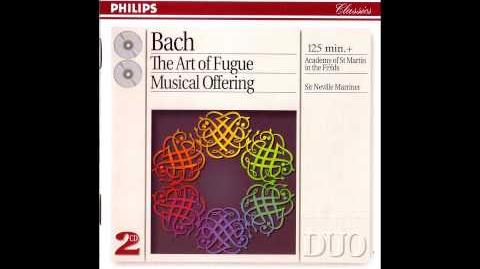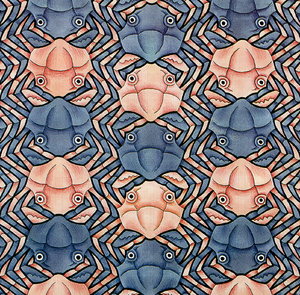Overview[]
A Dialogue based on a piece by the same name from the Musical Offering. Both are so named because crabs (supposedly) walk backwards. The Crab makes his first appearance in this Dialogue. It is perhaps the densest dialogue in the book in terms of formal trickery and level-play. Gödel, Escher, and Bach are deeply intertwined in this very short Dialogue. (p. x)
Topics[]
Bach's Crab Canon[]

Bach - Canon 1 a 2 ("Crab Canon") (Marriner)
From the Musical Offering (BWV 1079). Performed on strings by Academy of St. Martin in the Fields, directed by Sir Neville Marriner.
The Crab Canon is the first of several two-part canons in the Musical Offering.
By the way, Bach didn't give the piece a title. The name "canon cancrizans" -- "crab canon" -- was given by others later.
The Musical Offering is different from most of Bach's works in that it was actually published in his lifetime. Here's what the Crab Canon looks like in that publication:
You may notice that the Crab Canon is performed by two instruments, but only one line is notated. What's the deal?
Bach published the canons in the Musical Offering as puzzles, giving the reader the minimum amount of information with which they can figure out the piece as long as they understand its structure. To "solve" a puzzle canon is to give it a structure that makes it fit together in pleasing harmony.
The Crab Canon is the first of the puzzle canons, and has the simplest solution -- which is that it needs to be performed forwards by one instrument and backwards by another.
The hint Bach provided in the score is that there are two clefs on the same staff. The symbol on the left side of the staff is a clef showing you where middle C is; it's a fairly unfamiliar clef these days, but it's completely standard musical notation. But then, on the right end of the staff, where a clef wouldn't usually go, is the same clef mirrored left-to-right.
The insight Bach wants you to get from this is that you should imagine mirroring the entire staff, and this gives you the other part of the music.
A crab canon is similar to a palindrome[]
As Hofstadter describes on p. 201, the structure of a crab canon is very similar to a palindrome, but not quite the same thing. It's only a palindrome if you combine the notes from the two parts together without distinguishing which part they came from.
Hofstadter points out that the structures called "palindromes" in DNA are the same thing. This jointly-palindromic structure is also the structure of this dialogue in GEB: it's a palindrome when you stop distinguishing Tortoise and Achilles, plus a few other subtle reversals.
A crab canon is not a Möbius strip[]
There is a surprisingly popular video on YouTube that claims that there's an isomorphism between the Crab Canon in Bach's Musical Offering and a Möbius strip. There isn't, but it convinces you that there is using a clunky computer animation that has very little to do with the structure of the canon.
I will not do this video the favor of linking to it. It doesn't need any more help taking over Google results.
This video doesn't inherently have anything to do with GEB, except that GEB re-popularized the term "crab canon". But the video is popular among readers of GEB, who seem to be particularly susceptible to this piece of misinformation.
As we've seen in the section above, the structure of this piece is well understood: one part plays its theme forwards, while the other part plays the same theme backwards. Hofstadter calls this the "defining property" of a crab canon (p. 201).
A Möbius strip is actually quite a different phenomenon, with different defining properties.
One interesting thing about a Möbius strip is that, when you travel around it by 360 degrees, you end up in the place you started, but upside down. (You also end up on the other "face" of the strip from where you started, if you care about that, which you often won't when you're considering the strip as an infinitely thin mathematical object.)
Flipping music upside down -- turning all its downward intervals into upward intervals, and vice versa -- is an interesting thing to do. It happens in some of the canons in the Musical Offering, which are called "canons by inversion".
The Crab Canon is not a canon by inversion. It doesn't ever mirror its theme on the musical scale: it mirrors it in time. This is the difference between flipping a musical staff top to bottom and flipping it left to right. The video creator may have gotten the inspiration for his video by confusing these at some point.
So how does the video fit the music onto a Möbius strip? Basically, by ignoring everything that makes it a Möbius strip!
Because there's nothing about a Möbius strip that would reverse the music in time, the video just starts two cursors going around the strip in opposite directions. This could have been done on a flat image, such as the score above or the one on p. 202 of GEB.
At any point on the strip, the video puts different music on the two sides (faces) of the strip. (Shouldn't a Möbius strip have only one face? Yes, but any local piece of it has two.) There's no particular relation between the music on one side and the music on the other. Again, a flat strip would have sufficed.
Bach notated the Musical Offering as "puzzles" so that you have to understand the structure to perform it correctly. When you find the right structure, everything lines up perfectly. The people solving the puzzles that Bach posed (mostly his students) had to try different musical structures that were hinted at by the score until they found one that fit together in harmony.
The Crab Canon fits together when you think of it as mirrored in time. If Bach's students had tried thinking of it as a Möbius strip -- if they had even known what a Möbius strip was in 1750 -- they would have found that nothing about it made sense, and gone on to try something different.
A video can make something appear to make sense that actually doesn't. Its viewers assume on faith that such a clever-looking video must actually make sense, and that it's their fault if they don't understand how. That's probably stopping some people from actually understanding the Musical Offering.
Escher's and Hofstadter's Crab Canon[]

Escher's "Crab Canon", as it appears on WikiArt.
Escher's untitled work labeled "Crab (No. 40)" in the mcescher.com gallery was "christened" by Hofstadter as "Crab Canon" as explained in Chapter XIX, due to its fortuitous relationship with the form and content of the dialog. Escher has written about Bach's influence on his work, but it's unknown whether this particular piece was inspired by the Crab Canon specifically.
By writing a dialogue of the same form as the Bach piece and the Escher work, Hofstadter was able to give the name "Crab Canon" a triple meaning.
Commentary[]
(This section is for adding your thoughts about the chapter. Sign what you write with your user name. Others may edit this section for length later. More free-form, unedited discussion can take place in the comment section below.)
